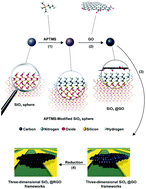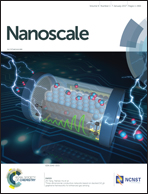Three-dimensional conductive networks based on stacked SiO2@graphene frameworks for enhanced gas sensing†
Abstract
Graphene is an ideal candidate for gas sensing due to its excellent conductivity and large specific surface areas. However, it usually suffers from sheet stacking, which seriously debilitates its sensing performance. Herein, we demonstrate a three-dimensional conductive network based on stacked SiO2@graphene core–shell hybrid frameworks for enhanced gas sensing. SiO2 spheres are uniformly encapsulated by graphene oxide (GO) through an electrostatic self-assembly approach to form SiO2@GO core–shell hybrid frameworks, which are reduced through thermal annealing to establish three-dimensional (3D) conductive sensing networks. The SiO2 supported 3D conductive graphene frameworks reveal superior sensing performance to bare reduced graphene oxide (RGO) films, which can be attributed to their less agglomeration and larger surface area. The response value of the 3D framework based sensor for 50 ppm NH3 and 50 ppm NO2 increased 8 times and 5 times, respectively. Additionally, the sensing performance degradation caused by the stacking of the sensing materials is significantly suppressed because the graphene layers are separated by the SiO2 spheres. The sensing performance decays by 92% for the bare RGO films when the concentration of the sensing material increases 8 times, while there is only a decay of 25% for that of the SiO2@graphene core–shell hybrid frameworks. This work provides an insight into 3D frameworks of hybrid materials for effectively improving gas sensing performance.


 Please wait while we load your content...
Please wait while we load your content...